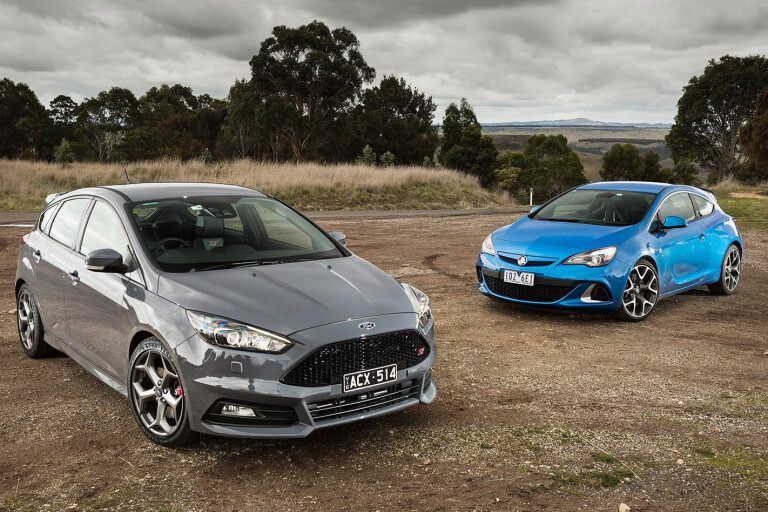
Welcome to the next generation of Ford versus Holden. For some die-hard traditionalists, the fact these vehicles are no longer Australian-made makes the rivalry an irrelevance, however for the companies themselves the competition for market share is fiercer than ever.
No longer will it be a straight head-to-head contest between large sedans, though, for the 21st-century battle will be fought on many fronts: front- and rear-wheel drive; fours, sixes and eights; hatch, coupe and SUV.
First into the fray are the Holden Astra VXR and the facelifted Ford Focus ST. The Astra is an automotive Lazarus, a phoenix rising from the ashes of Opel’s failed Australian experiment. With the VXR having spent two years in the wilderness, Holden finds itself in the unusual position of launching a three-year-old car.
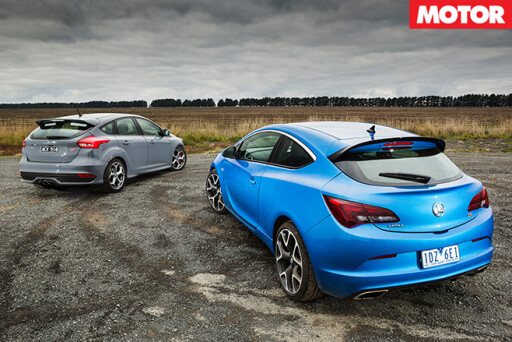 It’s an issue brought into sharp focus by the, er, Focus, which despite being of similar vintage has just received a major update consisting of revised styling, a much-needed interior update and a few mechanical tweaks to its chassis.
It’s an issue brought into sharp focus by the, er, Focus, which despite being of similar vintage has just received a major update consisting of revised styling, a much-needed interior update and a few mechanical tweaks to its chassis.
On paper, there’s very little to choose between the two. Both are front-wheel drive hatches with 2.0-litre turbocharged four-cylinder engines, available only with a six-speed manual gearbox. The Astra’s impressive 206kW and 400Nm towers over the Focus’s 184kW and 360Nm, but the Holden’s portly 1543kg kerb weight narrows its power-to-weight advantage to just a single kilowatt-per-tonne, 134kW/tonne versus the Ford’s 133kW/tonne.
Perhaps unsurprisingly, this equality led to the two recording identical numbers on the drag strip, though neither is exactly a barrel of laughs to performance-test. With so much power feeding through the front wheels, wheelspin is easily induced, yet a far greater hindrance is the vicious axle tramp that afflicts both cars.
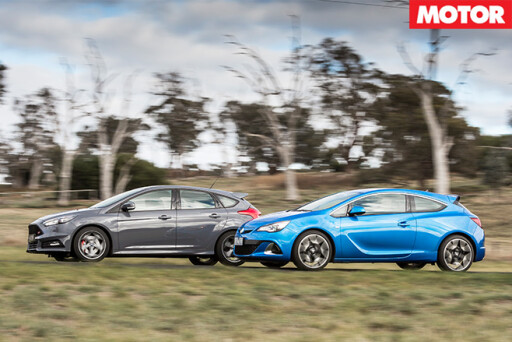 Try to launch with j-u-s-t the right amount of slip and both cars shake so violently you worry the dashboard will fall out of its mounts, while the tyres leave a staccato trail of rubber on the launch pad as evidence of their torture.
Try to launch with j-u-s-t the right amount of slip and both cars shake so violently you worry the dashboard will fall out of its mounts, while the tyres leave a staccato trail of rubber on the launch pad as evidence of their torture.
Still, with perseverance both cars eventually clock 0-100km/h in 6.4sec and a 14.7sec quarter mile. Impressively, the Focus manages to beat its claim by 0.1sec, though getting that number requires you to stretch second gear right to the 6800rpm cut-out (which equates to 102.5km/h), otherwise you’re looking at a low-seven.
Despite the identical times the Astra is the faster car, beating the Focus to 160km/h by a clear second. It suffers against the clock by feeling to fall off boost for a fraction of a second following fast gearchanges, and it needs a shift from third to fourth just as it crosses the quarter mile mark (though not making the gearshift is slower).
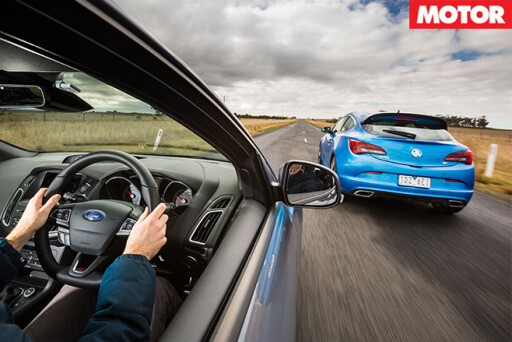 It’s at this point that the two begin to diverge, as for all their similarities in concept and performance they couldn’t be more different in personality and the way they deliver their driving thrills. One look is all it takes to realise that Holden and Ford are approaching the hot hatch segment from totally opposite ends of the spectrum.
It’s at this point that the two begin to diverge, as for all their similarities in concept and performance they couldn’t be more different in personality and the way they deliver their driving thrills. One look is all it takes to realise that Holden and Ford are approaching the hot hatch segment from totally opposite ends of the spectrum.
Like the Renault Sport Megane RS265, the Astra blurs the lines between hatch and coupe, its svelte three-door body sacrificing practicality for style. In this instance it’s a trade-off worth making as the VXR looks sensational, its squat stance – from some angles it looks as wide as it is long – aided by guard-filling 20-inch wheels and crisp body creases.
Surprisingly, a glance at the spec sheet reveals the Focus is shorter (by 104mm), wider (18mm) and lower (11mm) than the Astra, something you’d never believe when looking at the two side-by-side.
 Regardless of the dimensions, the Ford is unlikely to be the subject of anyone’s smartphone wallpaper (the 21st century equivalent of the 1980s bedroom wall poster). Compared to the voluptuous Holden it has all the sex appeal of parliamentary question time, though its case isn’t helped by being painted the colour of dirty dishwater.
Regardless of the dimensions, the Ford is unlikely to be the subject of anyone’s smartphone wallpaper (the 21st century equivalent of the 1980s bedroom wall poster). Compared to the voluptuous Holden it has all the sex appeal of parliamentary question time, though its case isn’t helped by being painted the colour of dirty dishwater.
Things improve little on the inside. The piano black Nokia-inspired button-fest of the pre-facelift car has disappeared, replaced by an 8.0-inch touchscreen that’s home to the SYNC2 infotainment system. Unfortunately, the free space liberated by the flash new ’screen has resulted in the centre stack being swathed in hard grey plastic that looks and feels cheap.
There are other issues. While SYNC2 can no doubt be made to work reasonably well if you wade through the encyclopedia that is the instruction manual, it’s about as intuitive as patting your head and rubbing your tummy while cooking an omelette and juggling a chainsaw.
Case in point: to input a sat-nav destination using voice activation (which you have to use while on the move) you have to know a street in the town you’re travelling to. If you only know the town name, tough luck. It might seem like a small thing, but its obstinance will drive you up the wall.
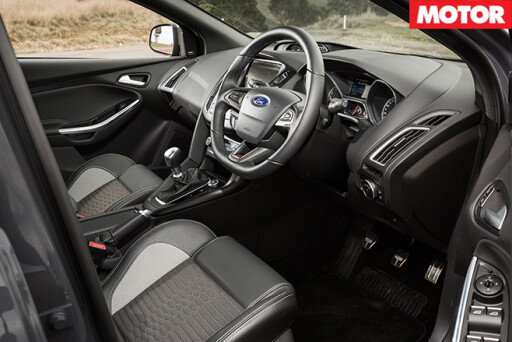 That said, the driving position is good, the soft-touch dash is nice, the steering wheel is a delight to hold and the snug Recaro seats hold you tightly in place. At least they do if you’re very slim – more than one passenger complained that they didn’t really ‘fit’ in the seats, and these weren’t large people.
That said, the driving position is good, the soft-touch dash is nice, the steering wheel is a delight to hold and the snug Recaro seats hold you tightly in place. At least they do if you’re very slim – more than one passenger complained that they didn’t really ‘fit’ in the seats, and these weren’t large people.
Don’t think this means it’s an easy win for the Holden, though. The Astra’s centre stack is an ergonomic disaster, a bamboozling assortment of buttons and dials. And while the infotainment unit is familiar from the Commodore, it lacks touchscreen functionality, so adjusting audio/sat-nav etc. is now slow and clunky.
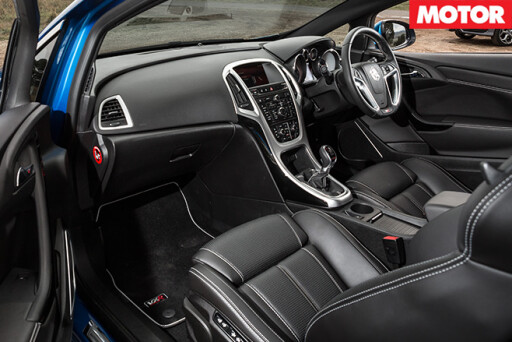 Its driving position is set a little too high, but its seats are much more adjustable than those in the Ford and the squared-off steering wheel is similarly pleasing to hold. For some, that the Focus has rear doors will make it the only choice, though once you’ve contorted yourself into the back of the Astra there is actually plenty of room. The Holden also has the bigger boot with 380 litres playing 313.
Its driving position is set a little too high, but its seats are much more adjustable than those in the Ford and the squared-off steering wheel is similarly pleasing to hold. For some, that the Focus has rear doors will make it the only choice, though once you’ve contorted yourself into the back of the Astra there is actually plenty of room. The Holden also has the bigger boot with 380 litres playing 313.
But it’s what happens when you sink the slipper that matters far more than what you put in the boot. And once again, in concept and execution, these are two very different hot hatches. GM threw the kitchen sink at the Astra VXR, stuffing it with so much brand name gear that it almost needs a ‘shopping list’ written on the front guards, Japanese tuner-car style.
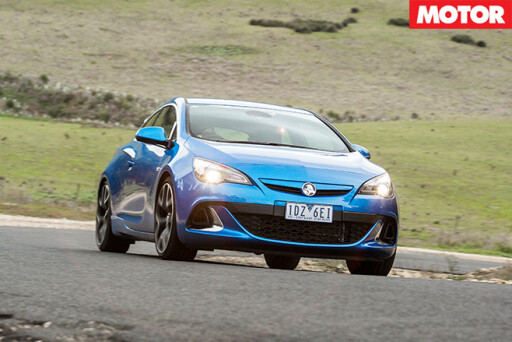 There’s the clever torque reducing HiPerStrut front suspension system, Brembo supplies the brakes, Sachs the electronically-adjustable dampers, Drexler the limited-slip differential, and it was all set up at the Nürburgring Nordschleife.
There’s the clever torque reducing HiPerStrut front suspension system, Brembo supplies the brakes, Sachs the electronically-adjustable dampers, Drexler the limited-slip differential, and it was all set up at the Nürburgring Nordschleife.
In contrast, the Focus ST couldn’t be simpler. In fact, there’s not much to talk about – no limited-slip diff, adjustable suspension or tricky front suspension. Ford claims that its electric power steering system is so good at compensating for torque steer that it doesn’t need any mechanical help, but Ford is telling furphies.
The Focus ST is all too eager to spin up an inside wheel and you’re guaranteed to find yourself wrestling with the steering under full throttle on anything less than a perfectly smooth road. The engine itself is a gem, though, with a broad spread of power, great response and a rorty (though artificial) soundtrack. It’s matched to a gearbox with well-spaced ratios and a light, reasonably accurate shift.
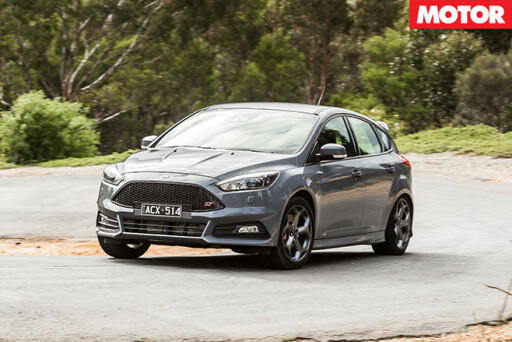 It’s not the world’s slickest ’box, but it’s far preferable to that of the Astra, which is long-throw, vague and has synchros that are easily beaten on quick shifts. Crunch. Thankfully, the longer ratios both limit the number of shifts required and make the most of the Holden’s relatively narrow power band.
It’s not the world’s slickest ’box, but it’s far preferable to that of the Astra, which is long-throw, vague and has synchros that are easily beaten on quick shifts. Crunch. Thankfully, the longer ratios both limit the number of shifts required and make the most of the Holden’s relatively narrow power band.
Breathing in 21psi of boost, the turbo takes a while to come on song yet progress feels to slow dramatically beyond 5500rpm. There’s nothing wrong with the speed of the Astra, but its workmanlike character and industrial soundtrack mean it’s not the most exciting engine around.
The corners themselves, however, are far more entertaining. With 245/35 Michelin Pilot Super Sports at each corner, the grip levels the Astra can generate are astounding. In fact, it’s difficult to think of a front-drive hot hatch that could live with the VXR, particularly in tricky conditions. In faster corners the LSD nails the front end to the ground, while providing excellent traction exiting tighter bends.
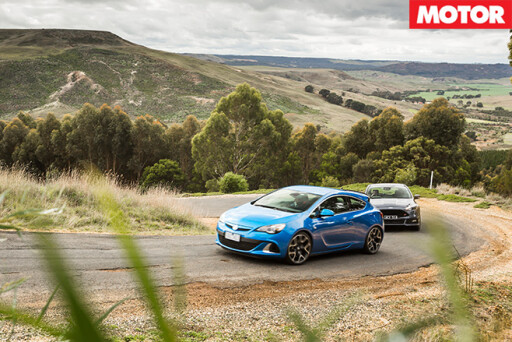 As you’d expect from a car developed at the ’Ring, its chassis errs towards stability – though it will still slide the rear in certain circumstances – but it inspires confidence rather than inducing boredom, allowing you to push the Astra right to its limits.
As you’d expect from a car developed at the ’Ring, its chassis errs towards stability – though it will still slide the rear in certain circumstances – but it inspires confidence rather than inducing boredom, allowing you to push the Astra right to its limits.
Unfortunately, fairly severe steering kickback rears its ugly head over mid-corner bumps and the brakes, while powerful, also feel awful, with a large dead spot in the first couple of centimetres of pedal travel.
However, these flaws fail to detract from what is an impressive performance, and in terms of speed at least, it’s one the Focus can’t match. But the Ford has other tricks up its flat grey sleeves.
Y’see, whereas the Astra is like the model student sitting attentively in the front row, the Focus ST is the class clown, reclining on its chair at the back of the room blowing spitballs and making rude signs at the teacher. It’s not particularly interested in going fast, that’s too boring, it just wants to have fun, swinging its tail about like a dog that hasn’t seen its owner in a month.
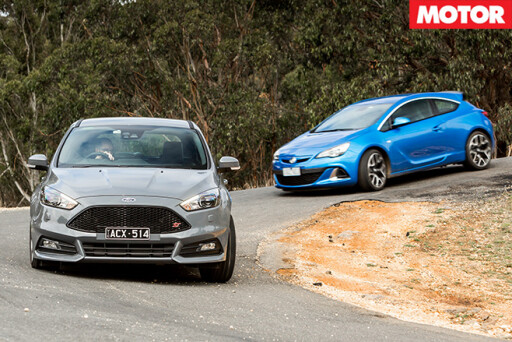 If you’re not familiar with the phenomenon of lift-off oversteer, the Focus ST is likely to give you a crash course – possibly literally if you’re not very experienced. With its extremely fast steering rack (just 1.8 turns lock-to-lock) the Ford doesn’t have a lot of lock, which not only gives it the turning circle of a semi-trailer but also means it can only go so far sideways before it’s beyond saving.
If you’re not familiar with the phenomenon of lift-off oversteer, the Focus ST is likely to give you a crash course – possibly literally if you’re not very experienced. With its extremely fast steering rack (just 1.8 turns lock-to-lock) the Ford doesn’t have a lot of lock, which not only gives it the turning circle of a semi-trailer but also means it can only go so far sideways before it’s beyond saving.
Still, you’re extremely unlikely to reach such limits on the public road, instead you’ll revel in the way the chassis adjusts to every movement of your right foot. The steering is more communicative than the Holden’s and the brakes are no more powerful, but inspire much more confidence underfoot.
Its damping is excellent with great body control, though the price you pay is a ride that might be unacceptable for some; it could get wearing on long journeys. With its adjustable dampers set to ‘comfort’ the Astra has a pillowy pliancy over larger bumps that few other sports-focused cars can match. Its secondary ride isn’t quite as flash, as there’s only so much dampening 35-series tyres can do, but the VXR is a comfortable car to drive day-to-day.
 So why does it finish second? Despite myriad differences, these two are incredibly closely matched, and it’s tempting to call the contest a tie. But even though the Astra’s sheer ability is a real surprise, it can’t match the Focus’s depth of dynamic ability.
So why does it finish second? Despite myriad differences, these two are incredibly closely matched, and it’s tempting to call the contest a tie. But even though the Astra’s sheer ability is a real surprise, it can’t match the Focus’s depth of dynamic ability.
The Holden is a very enjoyable car, but also one you figure out quite quickly. We suspect you could live with the Ford a long while and still feel you were learning more about its abilities (and your own). And for that reason, it takes first blood in Holden versus Ford 2.0. Roll on, Round 2.
| FORD FOCUS ST | HOLDEN ASTRA VXR | |
| Body | 5-door, 5-seat hatch | 3-door, 5-seat hatch |
| Drive | front-wheel | front-wheel |
| Engine | 2000cc inline-4, DOHC, 16v, turbo | 1998cc inline-4, DOHC, 16v, turbo |
| Bore/Stroke | 87.5 x 83.1mm | 86.0 x 86.0mm |
| Compression | 9.3:1 | 9.3:1 |
| Power | 184kW @ 5500rpm | 206kW @ 5300rpm |
| Torque | 360Nm @ 2000-4500rpm | 400Nm @ 2400rpm |
| Power/Weight | 133kW/tonne | 134kW/tonne |
| Transmission | 6-speed manual | 6-speed manual |
| Weight | 1389kg | 1543kg |
| Suspension | A-arms, anti-roll bar (f); multi-links, coil springs, anti-roll bar (r) | struts, adaptive dampers, anti-roll bar (f); multi-links, adaptive dampers, anti-roll bar (r) |
| L/W/H | 4362/1858/1471mm | 4466/1840/1482mm |
| Wheelbase | 2648mm | 2695mm |
| Tracks | 1559/1549mm (f/r) | 1584/1588mm (f/r) |
| Steering | electrically-assisted rack-and-pinion | hydraulically-assisted rack-and-pinion |
| Brakes | 320mm ventilated discs, 2-piston floating calipers (f); 271mm solid discs, single-piston floating calipers (r) | 355mm ventilated discs, 4-piston calipers (f); 315mm solid discs. single-piston calipers (r) |
| Wheels | 18 x 8.0-inch (f/r) | 20 x 8.5-inch (f/r) |
| Tyres | 235/40 R18 (f/r); Goodyear Eagle F1 | 245/35 ZR20 (f/r); Michelin Pilot Super Sport |
| Price | $38,990 | $39,990 |
| Positives | Hilariously playful handling; superb engine; value for money | Searing pace; great ride/handling balance; looks sensational |
| Negatives | Firm ride; torque steer; interior ergonomics; turning circle | Uninspiring engine; average gearshift; heavy; confusing dash |
| Star Rating | 4/5 | 4/5 |

COMMENTS